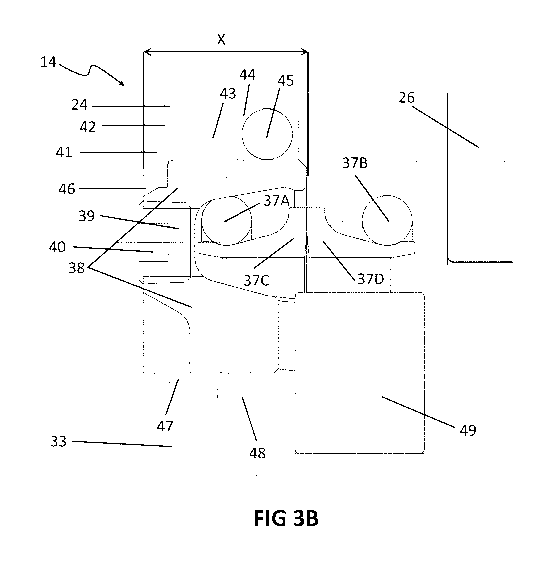Some of the information on this Web page has been provided by external sources. The Government of Canada is not responsible for the accuracy, reliability or currency of the information supplied by external sources. Users wishing to rely upon this information should consult directly with the source of the information. Content provided by external sources is not subject to official languages, privacy and accessibility requirements.
Any discrepancies in the text and image of the Claims and Abstract are due to differing posting times. Text of the Claims and Abstract are posted:
| (12) Patent Application: | (11) CA 2903301 |
|---|---|
| (54) English Title: | ROLLER CUTTER WITH IMPROVED SEALING |
| (54) French Title: | TREPAN A MOLETTES A ETANCHEITE AMELIOREE |
| Status: | Deemed Abandoned and Beyond the Period of Reinstatement - Pending Response to Notice of Disregarded Communication |
| (51) International Patent Classification (IPC): |
|
|---|---|
| (72) Inventors : |
|
| (73) Owners : |
|
| (71) Applicants : |
|
| (74) Agent: | GOWLING WLG (CANADA) LLP |
| (74) Associate agent: | |
| (45) Issued: | |
| (86) PCT Filing Date: | 2014-03-07 |
| (87) Open to Public Inspection: | 2014-09-25 |
| Availability of licence: | N/A |
| Dedicated to the Public: | N/A |
| (25) Language of filing: | English |
| Patent Cooperation Treaty (PCT): | Yes |
|---|---|
| (86) PCT Filing Number: | PCT/EP2014/054472 |
| (87) International Publication Number: | EP2014054472 |
| (85) National Entry: | 2015-09-01 |
| (30) Application Priority Data: | ||||||
|---|---|---|---|---|---|---|
|
A roller cutter (14) intended to be used at a drill head for rotary boring of the front of earth and rock formations, said roller cutter having a centre line (CL) and being provided with a hub (24) provided with rows of crushing members (29), at least one crushing member having its longitudinal axis at an angle relative to a normal to the centre line (CL), said hub being rotatable in relation to a shaft (33) having shaft spigots (34, 35), the roller cutter being provided with at least one seal retainer (38) arranged at an axial end of the hub in order to hold sealing means (37) in position, wherein the hub comprises at least one circumferential recess (44) positioned axially inward relative to a radially inward projecting flange (43) in the hub.
L'invention concerne un trépan à molettes (14) conçu pour être utilisé au niveau d'une tête de forage pour le forage rotatif d'un front de formations de sol et de roche, ledit trépan à molettes ayant un axe central (CL) et comportant un moyeu (24) doté de rangées d'éléments de broyage (29), au moins un élément de broyage ayant son axe longitudinal à un angle par rapport à une normale à l'axe central (CL), ledit moyeu pouvant tourner par rapport à un arbre (33) ayant des ergots d'arbre (34, 35), le trépan à molettes étant doté d'au moins un élément de rétention de joint (38) agencé à une extrémité axiale du moyeu afin de maintenir des moyens d'étanchéité (37) en position, le moyeu comprenant au moins un creux circonférentiel (44) positionné axialement vers l'intérieur par rapport à une collerette dépassant radialement vers l'intérieur (43) dans le moyeu.
Note: Claims are shown in the official language in which they were submitted.
Note: Descriptions are shown in the official language in which they were submitted.

2024-08-01:As part of the Next Generation Patents (NGP) transition, the Canadian Patents Database (CPD) now contains a more detailed Event History, which replicates the Event Log of our new back-office solution.
Please note that "Inactive:" events refers to events no longer in use in our new back-office solution.
For a clearer understanding of the status of the application/patent presented on this page, the site Disclaimer , as well as the definitions for Patent , Event History , Maintenance Fee and Payment History should be consulted.
| Description | Date |
|---|---|
| Application Not Reinstated by Deadline | 2019-03-07 |
| Time Limit for Reversal Expired | 2019-03-07 |
| Deemed Abandoned - Failure to Respond to Maintenance Fee Notice | 2018-03-07 |
| Change of Address or Method of Correspondence Request Received | 2018-01-10 |
| Letter Sent | 2015-12-04 |
| Inactive: Cover page published | 2015-10-30 |
| Letter Sent | 2015-10-14 |
| Letter Sent | 2015-10-14 |
| Inactive: Single transfer | 2015-10-01 |
| Inactive: Notice - National entry - No RFE | 2015-09-14 |
| Inactive: IPC assigned | 2015-09-11 |
| Inactive: First IPC assigned | 2015-09-11 |
| Application Received - PCT | 2015-09-11 |
| National Entry Requirements Determined Compliant | 2015-09-01 |
| Application Published (Open to Public Inspection) | 2014-09-25 |
| Abandonment Date | Reason | Reinstatement Date |
|---|---|---|
| 2018-03-07 |
The last payment was received on 2017-02-07
Note : If the full payment has not been received on or before the date indicated, a further fee may be required which may be one of the following
Patent fees are adjusted on the 1st of January every year. The amounts above are the current amounts if received by December 31 of the current year.
Please refer to the CIPO
Patent Fees
web page to see all current fee amounts.
| Fee Type | Anniversary Year | Due Date | Paid Date |
|---|---|---|---|
| Registration of a document | 2015-09-01 | ||
| Basic national fee - standard | 2015-09-01 | ||
| Registration of a document | 2015-10-01 | ||
| MF (application, 2nd anniv.) - standard | 02 | 2016-03-07 | 2016-02-08 |
| MF (application, 3rd anniv.) - standard | 03 | 2017-03-07 | 2017-02-07 |
Note: Records showing the ownership history in alphabetical order.
| Current Owners on Record |
|---|
| SANDVIK INTELLECTUAL PROPERTY AB |
| Past Owners on Record |
|---|
| JOONA LOIKKANEN |
| STIG-AKE BROLUND |